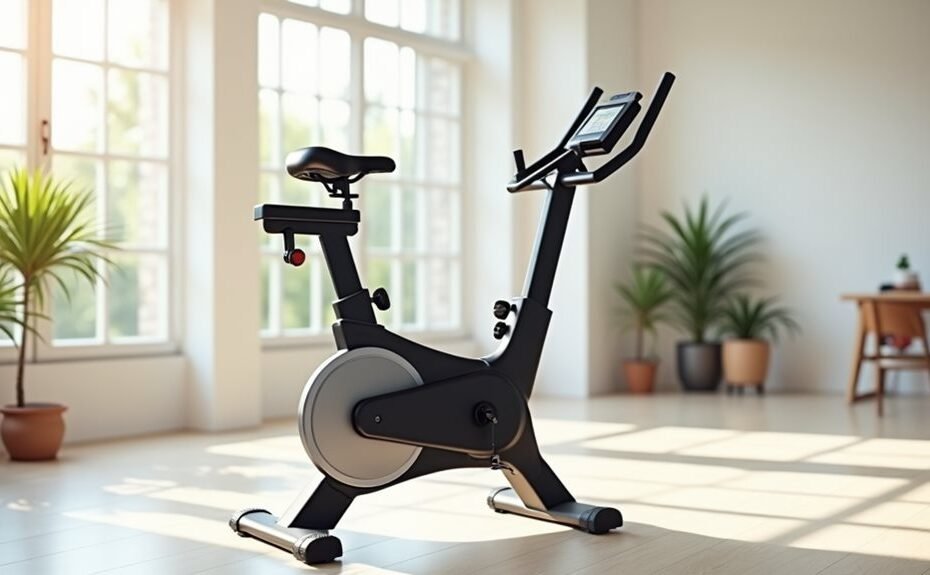I'll never forget the day I watched my neighbor transform from a fitness novice to a cycling enthusiast, all thanks to a budget-friendly static bike. As a fitness writer who's tested dozens of exercise machines, I've found that static bikes offer one of the most accessible entry points into home workouts, especially for those watching their wallets. You don't need to spend thousands on fancy equipment to achieve your fitness goals, but you do need to know what features matter and which ones you can skip. Let me show you how to make the smartest choice for your needs and budget.
Key Takeaways
- YOSUDA Indoor Cycling Bike offers excellent value at $300 with essential features for beginners, including adjustable settings and stable frame.
- Exerpeutic Folding Magnetic Bike provides affordable entry at $190 with space-saving design and basic tracking capabilities.
- Regular maintenance like weekly bolt tightening and monthly lubrication extends bike longevity, reducing long-term replacement costs.
- Low-impact workouts burn up to 500 calories per session while protecting joints, making static bikes ideal for fitness beginners.
- Look for bikes with at least 8 resistance levels, adjustable seats, and basic LCD displays for essential progress tracking.
Why Choose a Static Bike
When considering your first piece of home exercise equipment, a static bike offers compelling advantages that make it an excellent choice for beginners. Let me break down why it's your smartest bet for starting a fitness journey without breaking the bank – or your joints.
First, I'll point out the no-brainer safety factor. You won't have to dodge cars or battle weather conditions like you'd with outdoor cycling. Plus, you're getting a premium low-impact workout that'll be kind to your knees and hips – trust me, they'll thank you later. Interval training options make it easy to progress at your own pace while maximizing fitness gains. You can expect to burn up to 500 calories in a single session.
Here's what seals the deal: you're getting remarkable versatility. I'm talking about customizable resistance levels that grow with your fitness level, and the ability to multitask – yes, you can actually watch your favorite shows while burning calories. It's perfect whether you're a complete novice or working your way up to more intense workouts.
The health benefits are undeniable. You'll boost your cardiovascular fitness, build lower body strength, and torch calories – all while staying in complete control of your workout intensity. For beginners watching their budget, it's simply unbeatable.
Best Budget Options Under
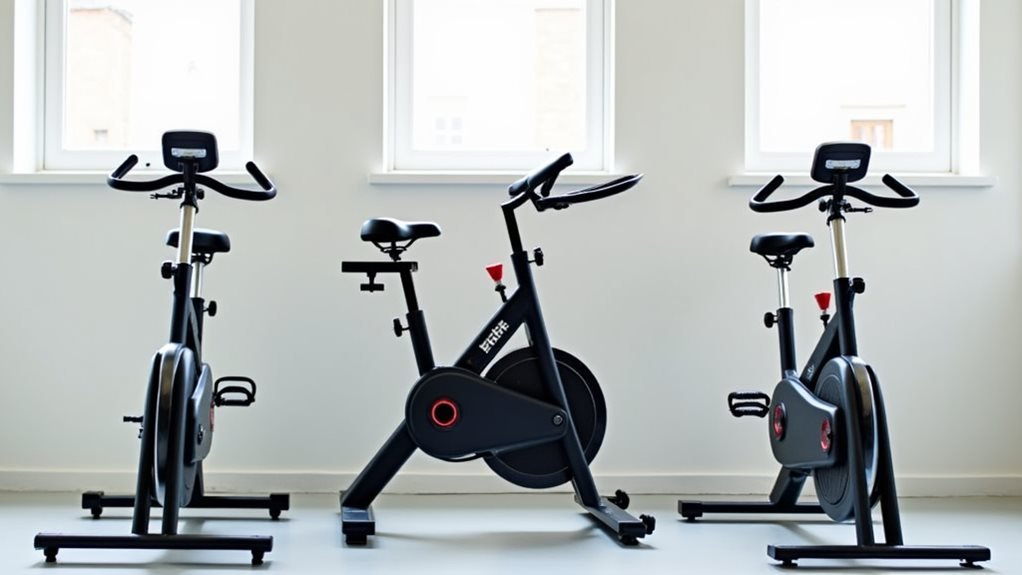
Four outstanding static bikes stand out in the budget-friendly under-$500 category, each offering unique advantages for different needs. I'll cut straight to the chase: YOSUDA's Indoor Cycling Bike hits the sweet spot at $300, delivering a solid 35-pound flywheel and magnetic resistance in a compact package. Trust me, those transport wheels will save your back. These bikes provide low-impact cardio that's ideal for beginners and those with joint concerns. Regular maintenance like cleaning and lubrication helps extend your bike's lifespan significantly. Home fitness trends have made indoor cycling more accessible than ever for budget-conscious consumers.
For those needing back support, I recommend Marcy's Magnetic Recumbent. It's comfortable, adjustable, and won't break your budget.
The Schwinn 130 Upright? It's a tech-savvy beast at $499, connecting to apps like Zwift while providing intermediate-level workouts. You'll have it assembled in 30 minutes flat.
Here's my budget-champion pick: the Exerpeutic Folding Magnetic at $190. It's the Swiss Army knife of exercise bikes – folds up smaller than your laundry basket, weighs just 39 pounds, and still delivers eight resistance levels. Perfect for apartment dwellers or anyone who doesn't want their living room looking like a gym. The magnetic resistance keeps it whisper-quiet, so you won't wake the neighbors during those midnight workouts.
Essential Features to Consider
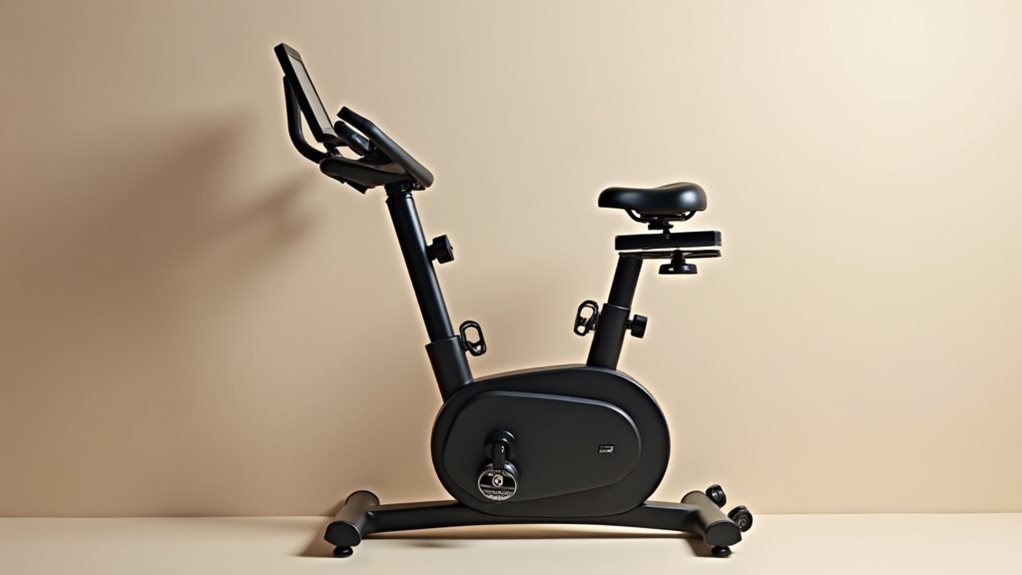
Success in finding the ideal static bike hinges on understanding its vital features. I'll cut straight to the chase – you need adjustability, stability, and proper monitoring to make your investment worthwhile. Let's break down what really matters when you're shopping on a budget. Upright bike designs can provide a comfortable riding position for beginners.
Basic exercise bikes that lack performance tracking are still effective for general fitness goals.
– Adjustable seat and handlebars are non-negotiable – they'll make or break your comfort level and riding efficiency
The Marcy Foldable Upright Exercise Bike offers a sturdy steel frame that proves durability doesn't have to be expensive.
- A solid resistance system gives you room to grow; I recommend at least 8 levels of adjustable resistance
- An LCD display is essential for tracking your progress – don't fall for fancy touchscreens if they'll blow your budget
- Frame stability trumps bells and whistles – look for a weight capacity that's at least 75 pounds above your weight
- Basic metric tracking capabilities will serve you better than premium features you won't use
Don't get distracted by high-end features that'll drain your wallet. Focus on these core elements, and you'll get a bike that'll serve your fitness journey effectively.
Resistance Types and Benefits
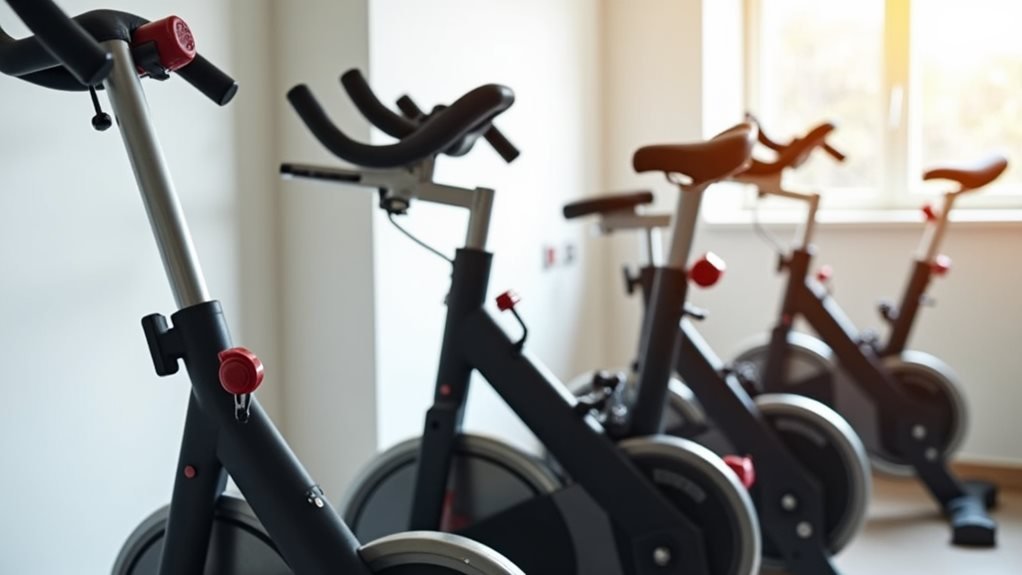
Now that you understand the core features to look for, let's talk about resistance systems – the heart of any static bike.
I'll cut straight to it: you've got two main choices – magnetic and friction resistance.
If you're on a tight budget, friction resistance is your friend. It's cheaper, offers intense workouts, and delivers that authentic road-bike feel you might crave. Stationary bike technology has evolved to make even budget models quite effective for home workouts. Yes, you'll need to replace brake pads yearly, but parts are cheap and maintenance is straightforward. Just be prepared for some noise – these aren't exactly library-friendly. The friction brake system applies direct pressure to the flywheel for resistance.
I'll be honest: magnetic resistance is the superior choice if you can expand your budget. It's whisper-quiet, maintenance-free, and delivers butter-smooth resistance changes. Plus, you'll get fancy features like programmable workouts and automatic adjustments. But here's the kicker – you'll pay notably more for these perks. The advanced engineering of magnetic systems ensures exceptional durability.
For beginners watching their wallet, I recommend starting with friction resistance. You'll get a solid workout without breaking the bank, and you can always upgrade later when you're ready to invest in those premium magnetic features.
Space and Storage Requirements
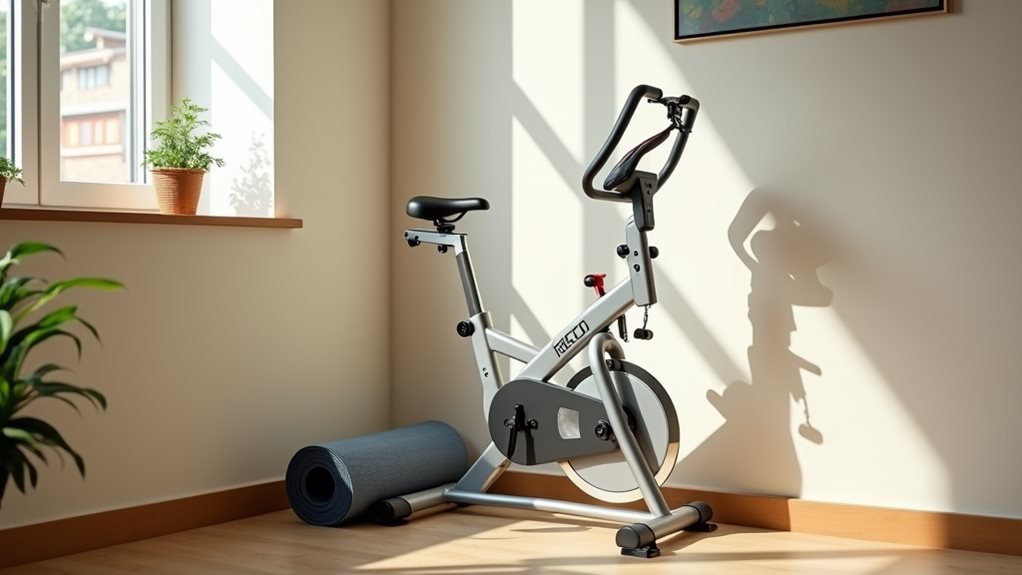
Let's explore the space requirements for your static bike setup. I'll cut straight to the chase: you need more room than just the bike's footprint. Most static bikes take up about 2' x 4' of floor space, but you'll need additional clearance for safety and functionality. The DeskCycle 2 offers a minimal footprint design for those with extremely tight spaces.
Here's what you absolutely must know about space planning:
- Standard footprints range from 22" x 32" (compact) to 25.5" x 48.25" (full-size)
- Allow at least 1 foot of clearance on all sides – more if you're training intensely
- Factor in 2-3 feet behind the bike for emergency dismounts
- Ceiling height matters – add your height plus 12 inches minimum
- Consider storage options if space is tight – some bikes fold to just 14" in length
If you're working with limited space, I've got good news: many modern bikes come with transport wheels and foldable designs. The Marcy Foldable Upright is a prime example, shrinking to just 14 inches when folded. Most bikes feature two front wheels to help with movement and positioning. Don't forget to check the bike's weight – they range from 37 to 160 pounds, which affects how easily you can move it around.
Comfort and Adjustability Factors
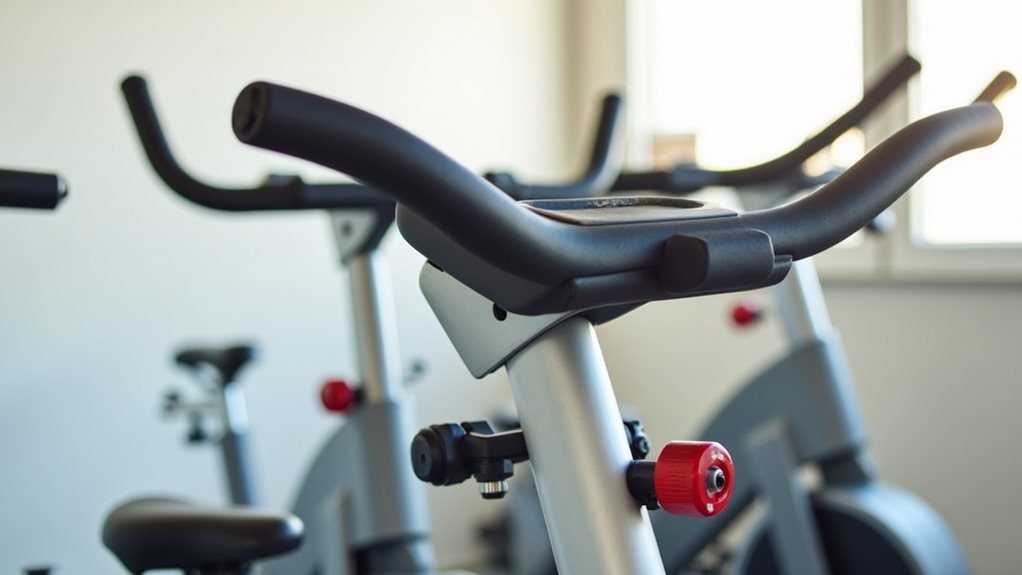
When it comes to getting the most out of your static bike, comfort and adjustability features make all the difference between an engaging workout and a frustrating experience. I'll tell you straight up – you need a bike that'll adapt to your body, not the other way around.
Let's start with the non-negotiables: adjustable seat height, handlebar positioning, and saddle fore/aft movement. I'm talking about a setup where your handlebars sit at or slightly above saddle height – trust me, your back will thank you.
If you're eyeing a recumbent bike, make sure it's got solid lumbar support and a wide seat. That's comfort 101.
Now, don't skimp on resistance systems. I want you to look for magnetic flywheels – they're quiet, smooth, and responsive. The best part? You'll get precise resistance control at your fingertips, perfect for progressive training.
Here's a pro tip: check if the bike's compatible with third-party apps. It's a game-changer for motivation, especially when you're starting out. And remember, a sturdy frame isn't just about durability – it's about giving you the confidence to push harder during workouts.
Maintenance and Longevity
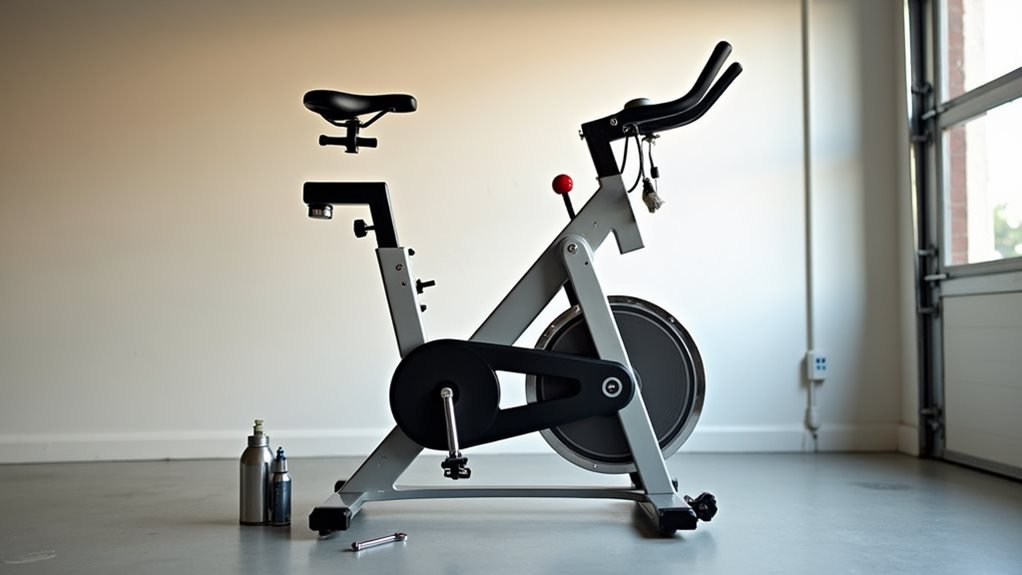
A well-maintained static bike can last for years, saving you money and preventing frustrating breakdowns. I'll tell you exactly what you need to do to keep your budget-friendly bike running smoothly.
Daily maintenance is your first defense against wear and tear. I always wipe down my bike after each use with a mild cleanser on a cloth – never spray directly on the frame. Trust me, it's worth the extra five minutes.
Here's your essential maintenance checklist to maximize longevity:
- Clean the flywheel weekly, rotating it while you wipe
- Tighten all bolts and screws every week – loose parts lead to expensive repairs
- Lubricate adjustment knobs monthly with silicone oil
- Check and clean the drive system (chain or belt) monthly
- Replace brake pads when resistance feels weak
I've learned that preventive care beats reactive repairs every time. For chain-driven bikes, monthly lubrication is non-negotiable. Belt-driven? You're in luck – just keep it clean and properly aligned. Remember, an annual professional service isn't just a suggestion – it's your insurance policy against major breakdowns.
Online Classes and Apps
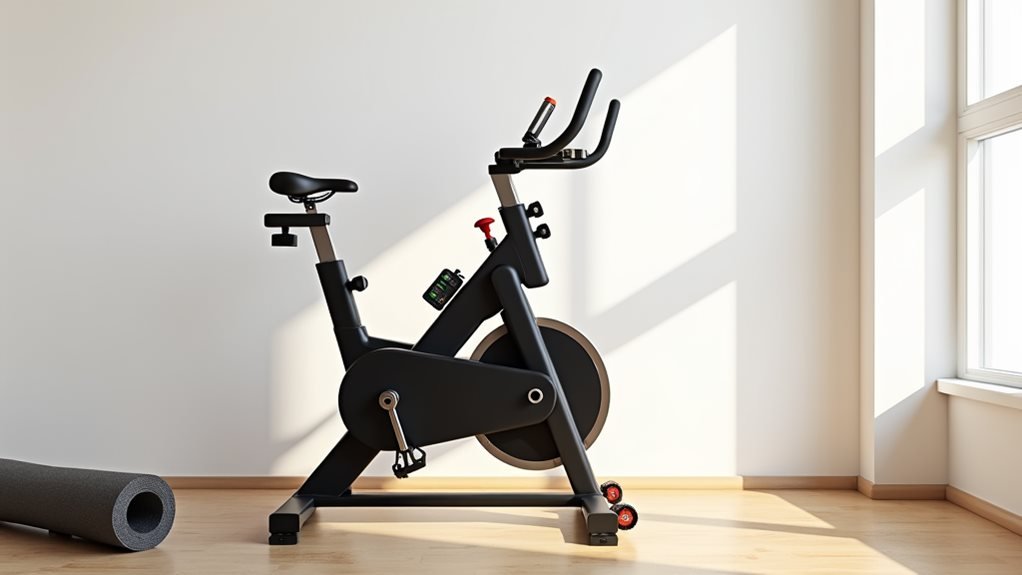
Three major advances have transformed budget static bikes into complete home fitness studios: app integration, online classes, and virtual training communities. I'll show you how today's budget bikes pack serious connectivity punch without breaking the bank.
| Feature | Budget-Friendly Option | Premium Alternative |
|---|---|---|
| App Integration | Horizon 7.0 IC with Zwift | Peloton with Native App |
| Class Access | Bowflex C6 + Third Party | Echelon with Smart Connect |
| Subscription Cost | Pay-per-app flexibility | Monthly commitment |
Look, you don't need to splurge on a Peloton to get connected training. The Bowflex C6 and Horizon 7.0 IC let you tap into multiple apps like Zwift and Strava without locking you into one ecosystem. I'm particularly impressed with how these bikes handle Bluetooth connectivity – they'll sync with your favorite fitness apps while letting you control resistance manually.
Want the full studio experience? The Echelon Smart Connect EX3 delivers unlimited workouts and live classes through their app. But here's the kicker: budget options like the Bowflex C6 let you access similar features through third-party apps at a fraction of the cost. It's all about choosing the connectivity level that matches your needs and budget.
Making Your Final Decision
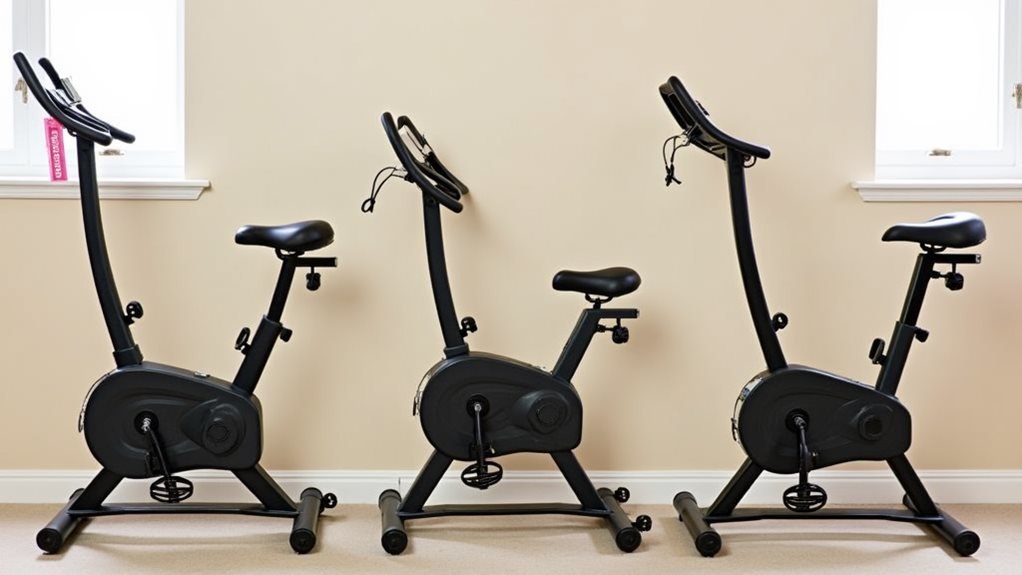
Making sense of all the features and options can feel overwhelming, but I'll help you zero in on what matters most for your specific needs.
I've narrowed down the key decision points to five essential factors that'll make or break your budget bike purchase.
- Pick a resistance system that fits your space – magnetic for whisper-quiet operation, friction if you don't mind some noise but want reliable resistance
- Don't skimp on adjustability – at minimum, you need adjustable seat height, handlebar height, and fore/aft positioning
- Match the weight capacity to your needs plus 50 pounds for safety margin
- Consider transportation – if you'll move the bike often, look for front wheels and a lightweight frame
- Prioritize comfort features based on your workout style – SPD clips for serious training, toe cages for casual use
Frequently Asked Questions
Can I Use My Static Bike if I Have Knee Problems?
I'll tell you that static bikes are great for knee problems since they're low-impact. Just make sure proper setup, start slowly, and stop if you feel pain. Consult your doctor first.
How Many Calories Can I Expect to Burn in 30 Minutes?
Pedaling persistently, I'd say you'll burn between 200-300 calories in 30 minutes, depending on your weight and intensity. If you're working vigorously, you might burn up to 400 calories.
Should I Wear Cycling Shoes or Will Regular Sneakers Work?
I'd recommend cycling shoes for better performance and safety, but you can start with regular sneakers. Just know you'll sacrifice some power transfer and stability with sneakers.
Is It Normal for the Seat to Feel Uncomfortable Initially?
By Jove, it's completely normal! I can tell you that new bike seats often feel uncomfortable at first, but they'll typically adjust to your body after several rides.
Can I Watch Netflix or Read While Using a Static Bike?
I'd recommend using Netflix over reading since it's safer. Most static bikes have phone mounts, but keep the workout intensity moderate to maintain proper form and effectiveness.
